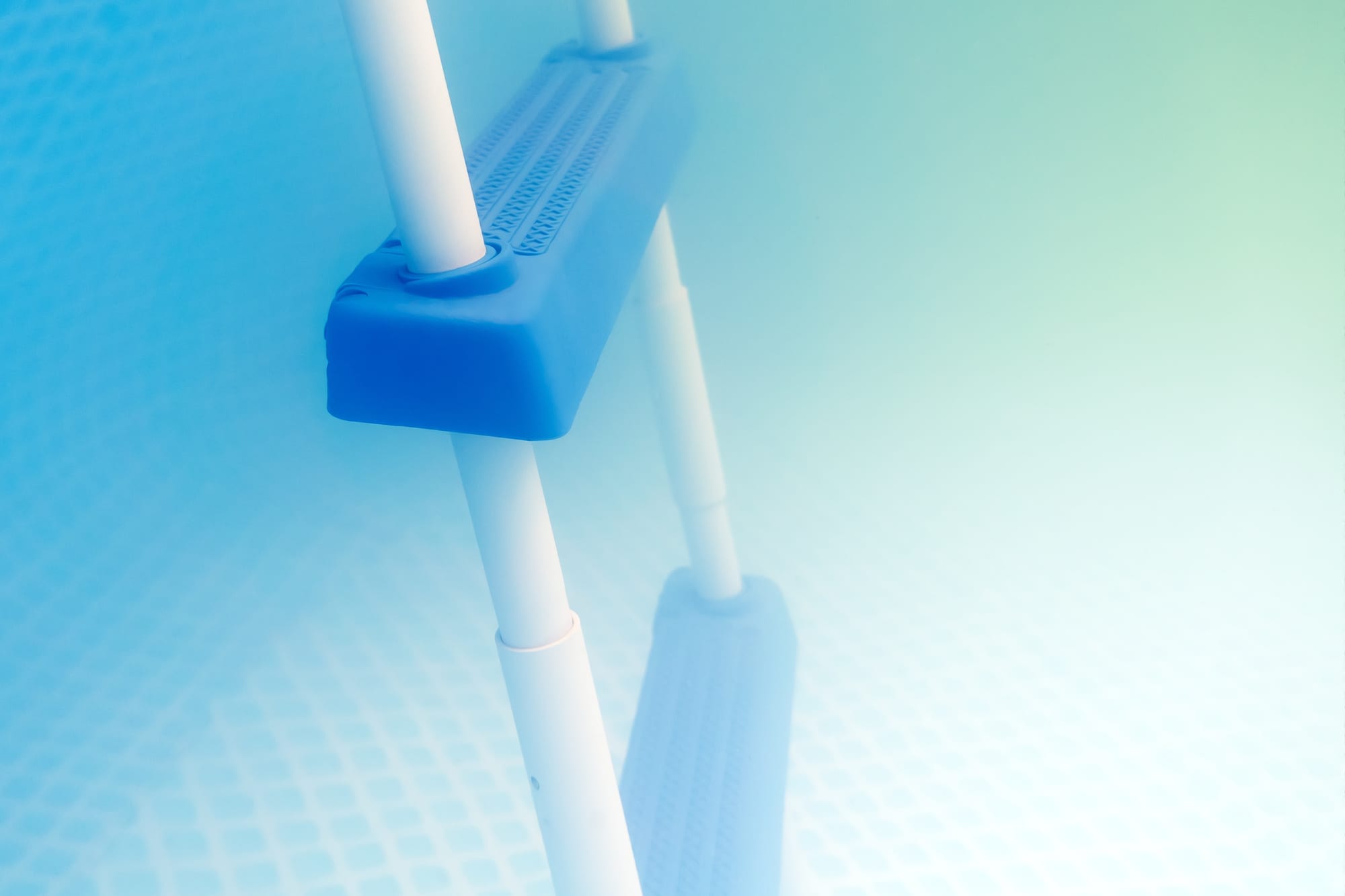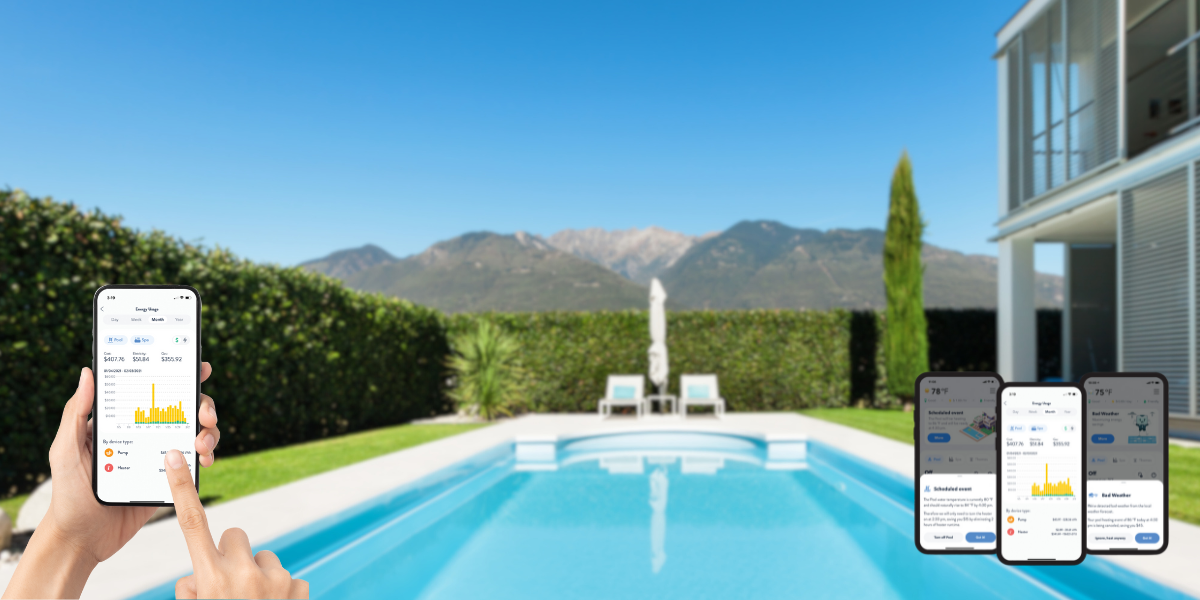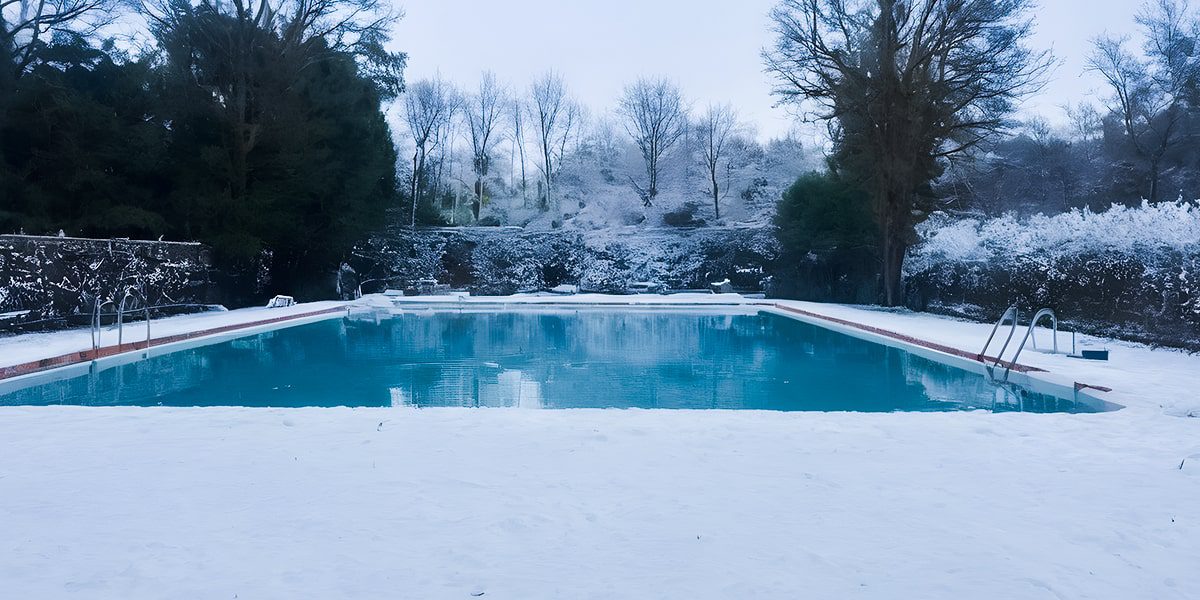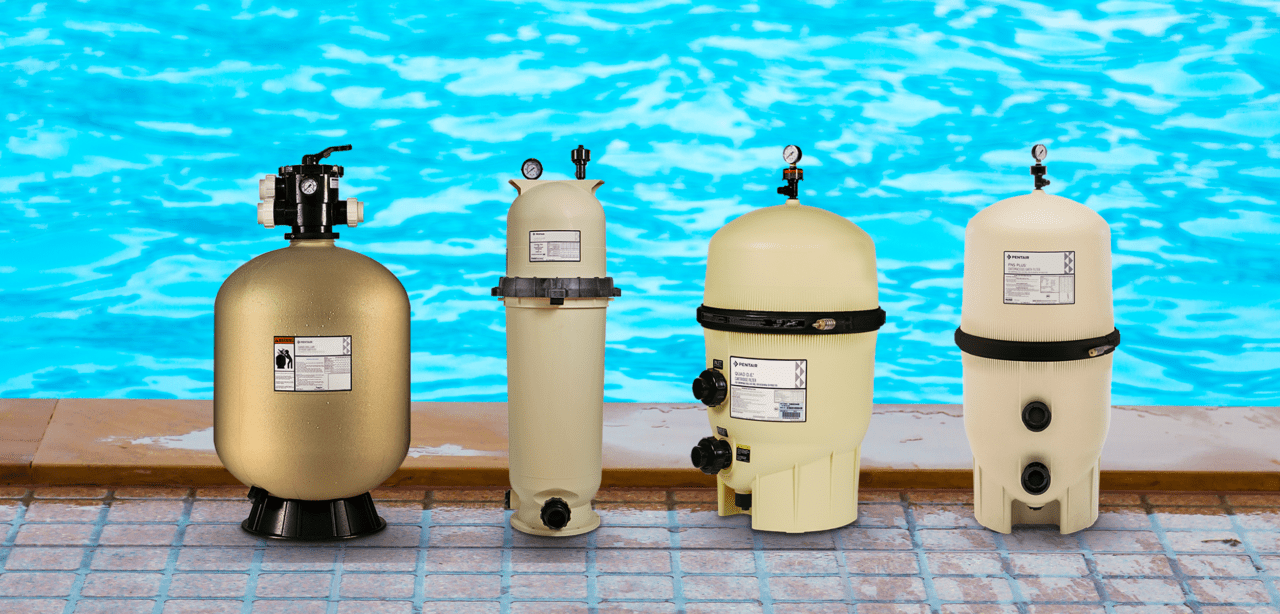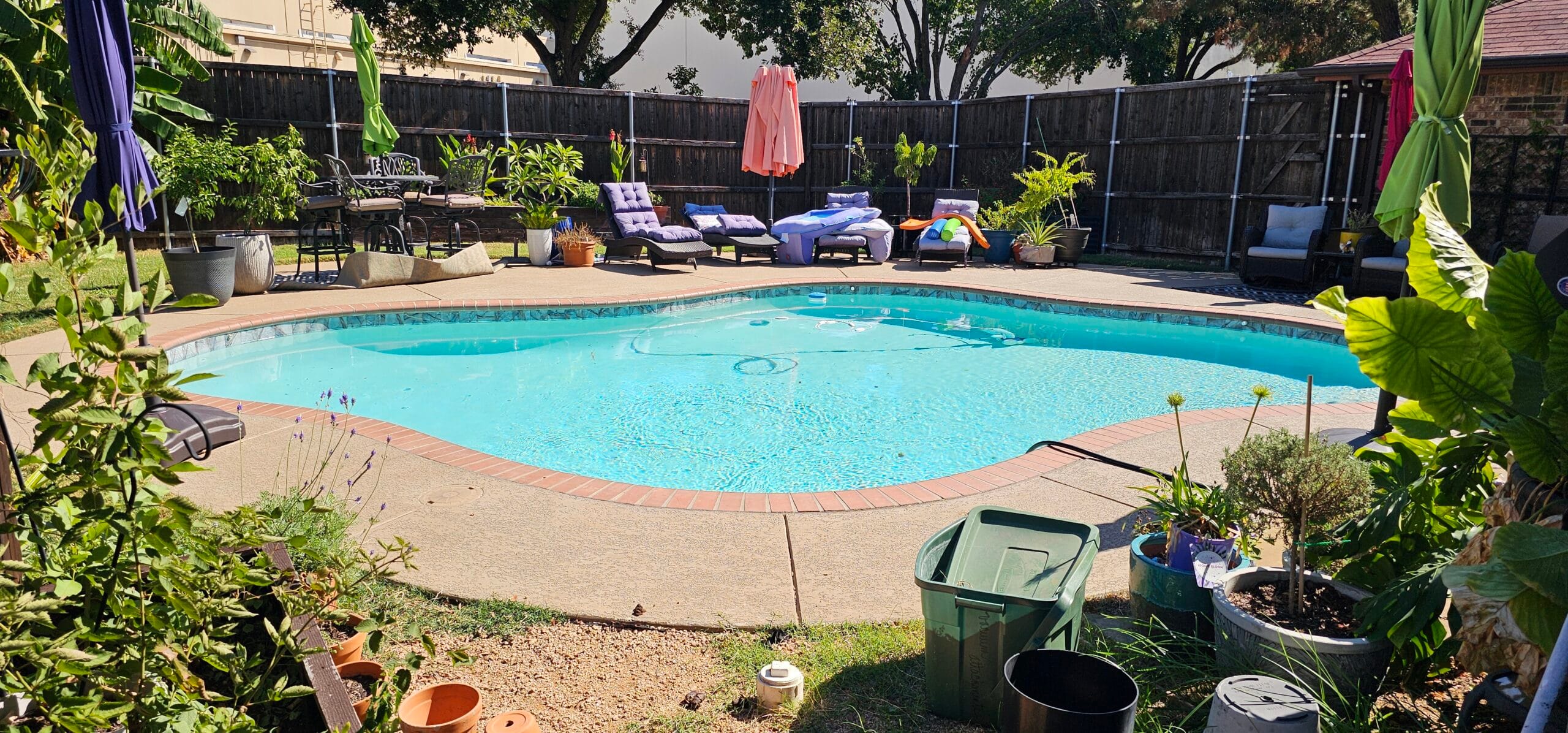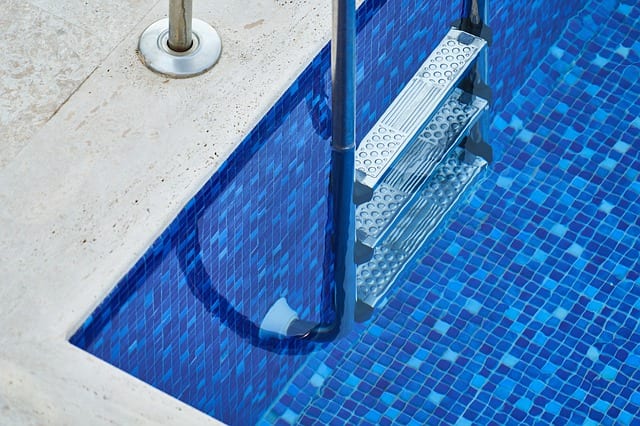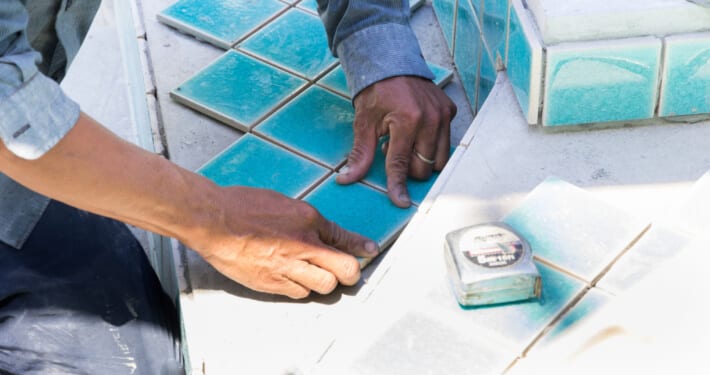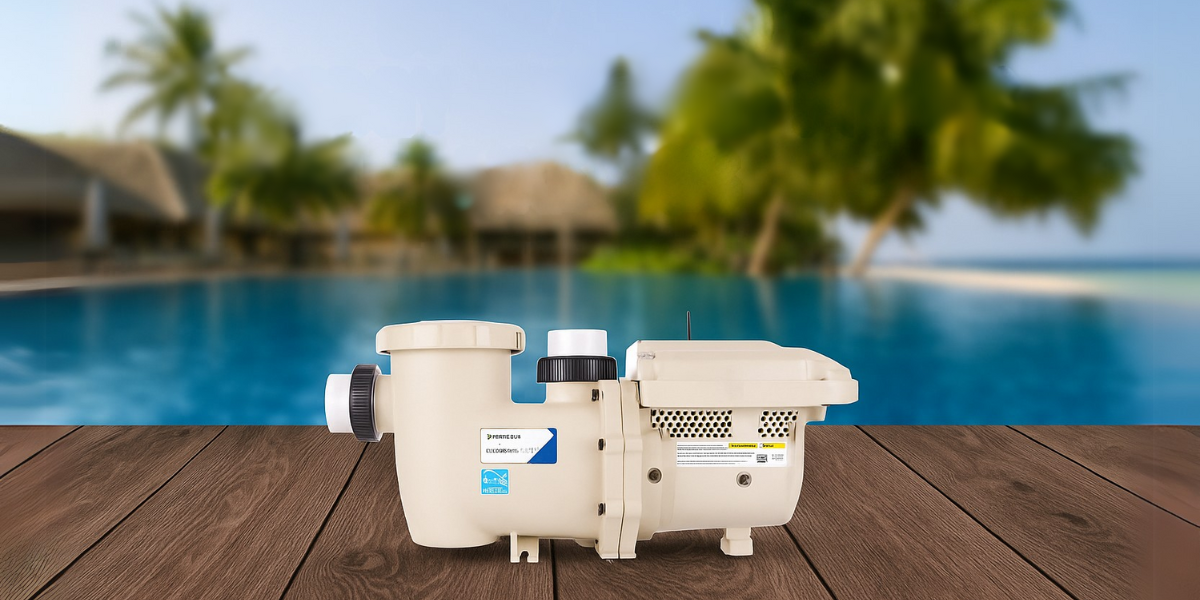The Health of the water in your swimming pool is dependent upon having a health pool pH And Maintaining the correct pH level in your pool is crucial for ensuring the comfort of swimmers, the effectiveness of sanitizers, and the longevity of your pool equipment. This guide covers everything you need to know about balancing your pool’s pH, including how to raise pH in pool when it’s too low, along with different testing methods, necessary chemicals, and common mistakes. Whether you’re dealing with low or high pH in your pool, understanding the basics and following proper methods will keep your pool in perfect balance year-round.
- Basics of pH in Pool Water
- What is ideal pH for pool water and Why it’s important
- How to Test pH level in pool
- What Happens if My Pool pH is Too Low?
- How to Rise pH in pool | Step by Step guide
- Pool Volume Calculator
- How to balance Alkalinity with Baking Soda:
- Sodium Bicarbonate vs Soda Ash Which Should You Use?
- Common Mistakes When Adjusting pH
- What to Do If You Add Too Much pH Increaser
- How often to check pool pH
- Looking For Professional Pool Service?
- FAQ
Basics of pH in Pool Water
The pH scale measures the potential of hydrogen, indicating the acidity or basicity of a substance. It ranges from 0 to 14, with values below 7 indicating acidity, above 7 indicating alkalinity, and seven being neutral. Adjusting pH levels in pool pH is crucial for water chemistry balance.

What is ideal pH for pool water and Why it’s important
An ideal pH range for ideal or healthy swimming pool water is between 7.4 and 7.8. This is important for a number of reasons, including:

- Effectiveness of Sanitizers: Chlorine and other sanitizers kill bacteria and algae most effectively in this range.
- Comfort for Swimmers: A pH of 7.4 is close to what the eye and skin are, which makes it less irritating. Anything below this will irritate eyes and bad for sensitive skin .
- Protecting the Pool equipment : When the pH is right, metal parts don’t rust and scale doesn’t form from excessive calcium.
- Clarity of Water: Water that is pH-balanced is clear and appealing.
- Value for money: Keeping the pH level balanced means using fewer chemicals and avoiding repairs that cost a lot of money.
How to Test pH level in pool
It’s important to check the pH levels of your pool before adding any chemicals. Testing helps ensure the water chemistry is balanced, preventing potential damage to your pool and maintaining swimmer comfort. Testing kits should be replaced once a year (usually at the beginning of pool season). If you haven’t replaced your kit yet this year, try purchasing a new one to use to test your pool water! Here’s a breakdown of the different ways to test pool pH:
Test The pH using pH Test Strips
Test strips are a quick and cheap way to check pool pH regularly. Even though they might not be as accurate as other methods, they make testing more often easier.

How to Use pH Test Strips:
Collect a Sample: Use a clean container to take a water sample from the center of your pool. Avoid areas near return jets or skimmers to get a more accurate representation of the overall water chemistry.
Dip the Strip: Put the test strip in water for the amount of time the instructions say to, usually only a few seconds. Following the steps on your test strip kit is very important.
Read the Results: Compare the color on the strip to the pH strips color chart provided with the kit. The chart will help you determine not just your pool’s pH but also other important levels like alkalinity and chlorine.

Pros: Quick, easy, and inexpensive.
Cons: Test strips may be less accurate than liquid or digital tests.
Check the pH How to Use a Liquid Test Kit
The average pool owner will use a liquid test kit because it is more accurate than a pH strip. Reagents, which are liquid chemicals, react with the pool water in these kits to show the pH level.

How to Use a Liquid pH Test Kit:
Get a Sample of the Water: Again, stay away from skimmers and jets as you fill the test tube with water from the middle of your pool.
Drop in the Reagent: Add the number of drops of pH reagent that the kit usually comes with that is suggested into the water sample.

Color Match: Give the water a light shake, and then look at the pH scale on the test kit to see if the color changes match the pH level of the pool.
Pros: More accurate than test strips.
Cons: Requires more time and effort.
Test the pH Using a Digital pH Meter
A digital pH meter is the most accurate method of testing pool pH. It costs more upfront, but the results are quick and precise, so it’s an excellent buy for testing regularly.

How to Use Digital pH Meter:
Set the meter up: A buffer solution must be used to set up a digital pH meter before it can be used. To set up the device, follow the directions that come with it.
Get a Sample of Water: Get Water from the middle of the pool and put it in a clean container, just like the other ways.
Test the Water: Put the digital meter’s tip into the water sample and press the button. The pH level will show up on the screen right away.
Pros: It gives very accurate results quickly.
Cons: It is expensive and requires calibration.
What Happens if My Pool pH is Too Low?
When your pool’s pH is too low (below 7.0), it can result in:
- Corrosion: Acidic water can corrode metal components like ladders, pool heaters, and pump seals, potentially leading to Pool leaks and other damage. It can also erode plaster, grout, and tile
- Irritated Skin and Eyes: Low pH causes the water to irritate swimmers’ skin and eyes. Dangerous for sensitive skin.
- Fast Chlorine Depletion: Low pH levels increase chlorine activity in a pool, causing it to be used up faster, which leads to the need for adding more chlorine to maintain proper sanitation.
- Staining and Etching: Acidic water can cause pool surfaces to stain or etch, leading to costly repairs
How to Rise pH in pool | Step by Step guide
Select the Right Chemical for Adjusting Pool pH.
Maintaining balanced water chemistry requires selecting the right chemical to raise the pH in swimming pool. Sodium bicarbonate, commonly known as baking soda, and sodium carbonate, also known as soda ash, are the two widely used chemicals to raise pH. Each one works differently and is suitable for specific situations.
Sodium Carbonate (Soda Ash) To Rise pH
Sodium carbonate, also known as soda ash, is a pH booster and has a more substantial base than baking soda and is specifically used to increase pH. It has a minimal impact on alkalinity, making it the go-to choice when alkalinity is already within the proper range and only pH needs adjustment.
You can add sodium carbonate (soda ash) to raise your pool’s pH levels. It’s a powerful alkaline substance that effectively increases pH without drastically affecting alkalinity.

Steps for Adding Soda Ash:
- Dosage: Add no more than two pounds of soda ash per 10,000 gallons of water per treatment. Exceeding this amount can lead to overcorrection or water cloudiness.
- Application: Start adding the soda ash from the deep end of the pool, then gradually move toward the shallow end. This method ensures that the soda ash is spread evenly across the pool.
- Circulation: After adding the soda ash, keep the pool filter running to help evenly distribute the chemical throughout the water.
Cloudiness: It’s normal for the pool water to turn cloudy after adding soda ash, but don’t worry! This cloudiness should clear up within 24 to 48 hours as the soda ash dissolves and the pool’s filtration system balances the water
Tips:
- Avoid adding too much at once to prevent high pH .
- Always test the pH level after the water has had time to circulate before adding more chemicals.
Pros: Quickly raises pH levels without a substantial effect on alkalinity. Effective for large pH adjustments.
Cons: Can cause cloudiness in the pool if added too quickly. Requires careful dosing to avoid raising pH too high.
Pool Volume Calculator
Click on your pool shape to calculate the volume of water.

Rectangle

Round
| Pool Volume | Maximum Soda Ash Per Treatment |
|---|---|
| 5,000 gallons | 1.0 lb (0.45 kg) |
| 1o,000 gallons | 2.0 lbs (0.9 kg) |
| 15,000 gallons | 3.0 lbs (1.36 kg) |
| 20,000 gallons | 4.0 lbs (1.81 kg) |
| 25,000 gallons | 5.0 lbs (2.27 kg) |
| 30,000 gallons | 6.0 lbs (2.72 kg) |
Sodium Bicarbonate (Baking Soda)
Sodium bicarbonate, commonly known as baking soda, is primarily used to raise alkalinity but also provides a slight increase in pH. It is ideal for minor pH adjustments, especially when pH and alkalinity are low. Alkalinity acts as a buffer that helps stabilize pH levels, so it’s essential to maintain proper levels alongside pH. If your pH levels are still too low after adding soda ash, it’s important to check the pool’s alkalinity. When alkalinity is too low, the pH can fluctuate wildly, making it difficult to maintain a proper balance.

Ideal Alkalinity Range
Your pool’s alkalinity should be between 80 ppm and 150 ppm. If alkalinity falls below this range, it can result in unstable pH levels that are hard to control.
How to balance Alkalinity with Baking Soda:
- Test the Alkalinity: Use a test kit to check your water’s total alkalinity.
- Dosage: If the alkalinity is too low, add 1.5 pounds of baking soda per 10,000 gallons of water. Baking soda, also known as sodium bicarbonate, is commonly used to raise alkalinity.
- Circulation: Allow the baking soda to circulate in the water by running the pool pump for at least one hour before retesting the alkalinity.
Baking soda not only increases alkalinity but also slightly raises the pH. This dual benefit makes it an effective and safe chemical to use when both levels need adjustment.
Amount of Baking Soda Required to Raise Alkalinity by Desired Amount:
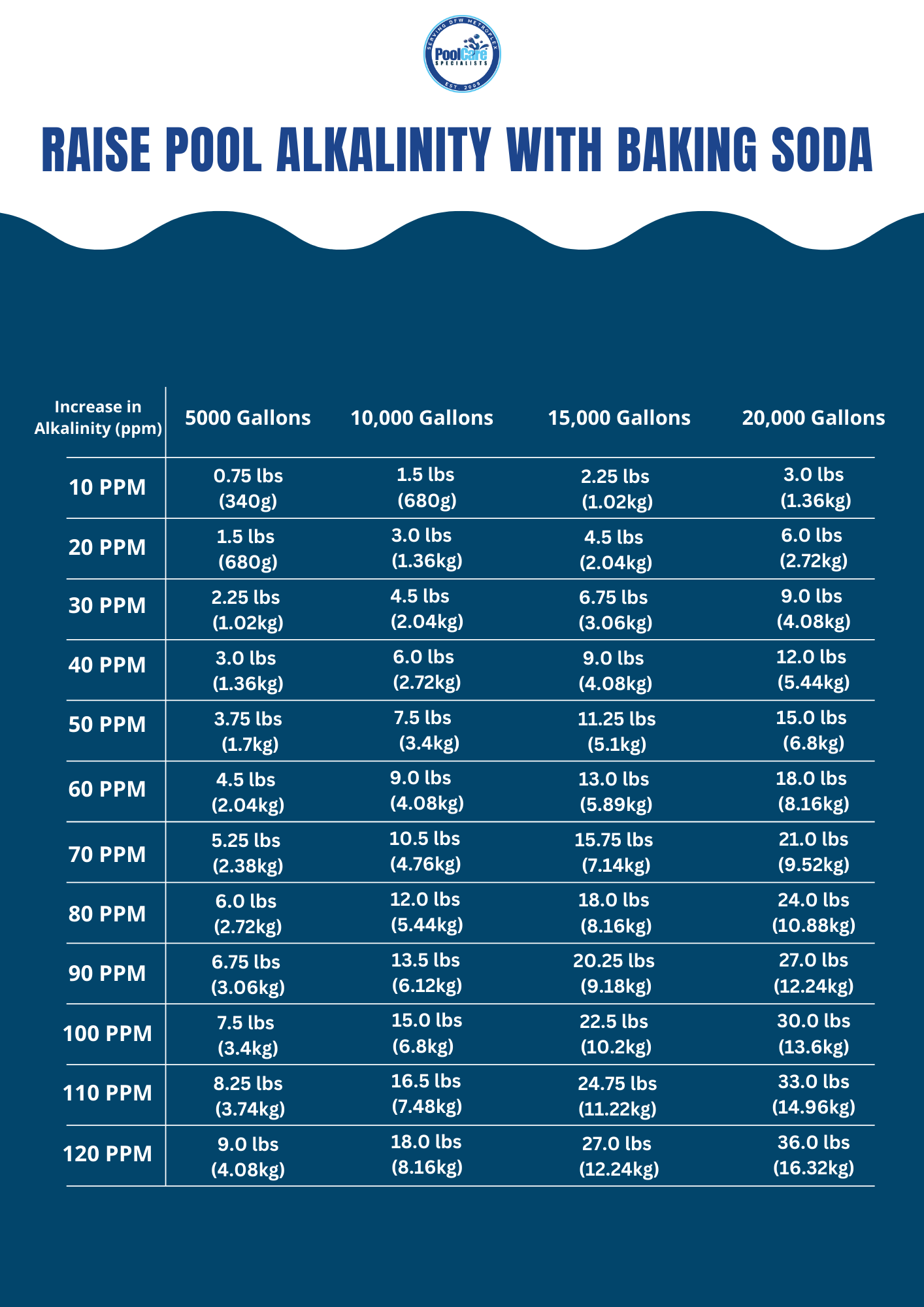
Caution:
Be mindful not to add too much baking soda, especially if you’ve already added soda ash earlier. Both chemicals can raise alkalinity, and once it becomes too high, it’s much harder to lower. High alkalinity can make balancing pH more difficult and may lead to cloudy water or scaling issues.
Always test both pH and alkalinity regularly to maintain balanced water chemistry and avoid over correcting either parameter.
Disclaimer:
The values in this chart are based on real-world observations and experiences. For best results, always follow the instructions printed on the product packaging. Pool care chemicals can have different effects depending on various factors like water chemistry, so ensure to check levels regularly and adjust as necessary.
Sodium Bicarbonate vs Soda Ash Which Should You Use?
When it comes to adjusting pool pH, both sodium bicarbonate (baking soda) and sodium carbonate (soda ash) have their uses, but which one you should choose depends on whether you’re primarily adjusting pH or alkalinity. Understanding the differences will help ensure you’re maintaining the right balance for your pool.
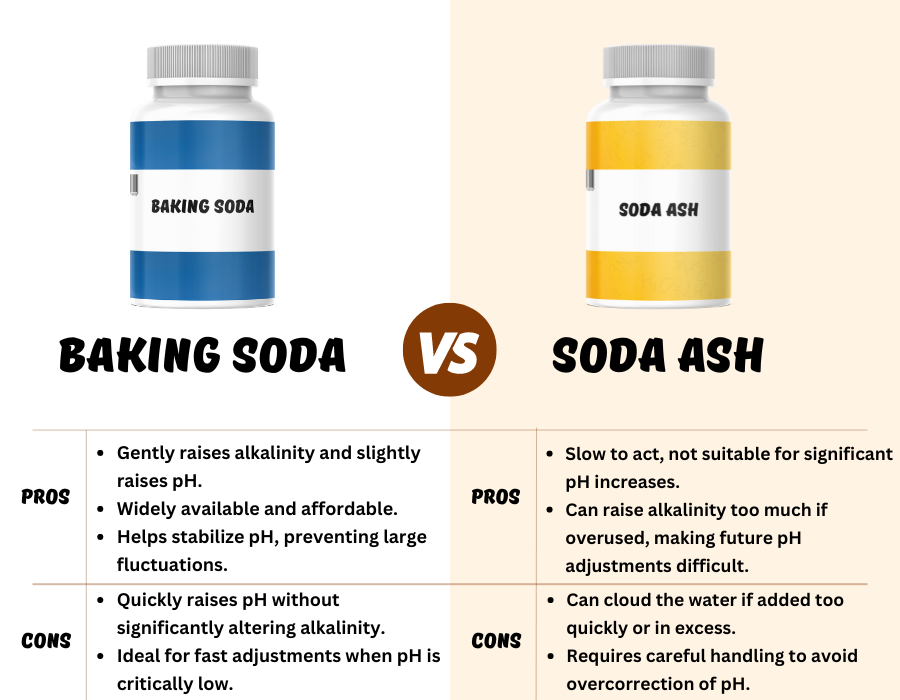
Common Mistakes When Adjusting pH
It’s important to keep your pool’s pH level at the right level for swimmer comfort and maintenance, but some pool owners make common mistakes when adjusting the pH. These mistakes can lead to water imbalance, costly repairs, and ineffective sanitization. If you know about these mistakes, you can avoid making them and keep your pool chemistry balanced.
1. Adding Too Much pH Increaser
One of the most frequent mistakes is adding too much pH increaser at once. Whether you’re using sodium carbonate (soda ash) or sodium bicarbonate (baking soda), overcorrecting can cause the pH to spike, leading to cloudy water, scaling, and inefficient chlorine usage. It’s important to add chemicals incrementally and retest the water between treatments. Overcompensating can result in high pH levels that are hard to lower.
2. Not Testing Alkalinity First
Alkalinity acts as a buffer that stabilizes pH. Changing the pH without checking the alkalinity can cause changes that are hard to predict. The pH level can change a lot if the alkalinity is too low. However, high alkalinity makes it challenging to change pH at all. To make sure that pH changes don’t disrupt the balance, you should always check and fix the alkalinity first.
3. Ignoring Other Pool Chemicals
Some pool owners forget that other chemicals, like chlorine or stabilizers, also affect pH. For instance, adding large amounts of chlorine can lower the pH, while calcium-based pool products can raise it. When making adjustments to pH, it’s important to consider the other chemicals in your pool to avoid unintended shifts in water balance.
4. Adding Chemicals Too Quickly
Adding chemicals to your pool too quickly, especially in large quantities, can cause the pool water to become cloudy or damage equipment. This is especially true for soda ash, which needs to be dissolved slowly and evenly across the pool to avoid cloudiness or scaling. Always allow time for proper circulation of the chemicals before adding more.
5. Not Running the Pool Pump Long Enough
Another common error is not running the pool pump long enough after adding chemicals. The pump helps circulate the water and evenly distribute the chemicals, ensuring accurate adjustments. If the pump isn’t run long enough, parts of the pool water may remain untreated, leading to localized imbalances in pH and alkalinity.
6. Misusing pH Testing Methods
Accurate pH adjustments rely on proper testing. Using outdated or expired test kits, not taking water samples correctly (e.g., too close to return jets for skimmers), or neglecting to clean your testing equipment can all lead to inaccurate readings. Always use fresh testing supplies and follow the manufacturer’s instructions for collecting samples to avoid misdiagnosing your water chemistry.
What to Do If You Add Too Much pH Increaser
If you accidentally added too much sodium carbonate or sodium bicarbonate to your pool, it can cause issues like cloudy water, scaling, and reduced chlorine effectiveness. To correct this, test the water and confirm the current pH level using a reliable test kit or strips. If the pH is above the ideal range of 7.4 to 7.8, action needs to be taken to bring it back down. Use a pH reducer, such as muriatic acid or sodium bisulfate (dry acid), to lower the pH to the optimal range. Start with a small amount and retest after circulation to avoid overcorrection. After adding the pH reducer, run the pool pump for 2 to 4 hours to ensure the chemical circulates evenly and is properly distributed. Retest the pH level after the water has circulated, and if it’s still above the recommended range, add a small additional dose of pH reducer.
How often to check pool pH
You should test your pool’s pH levels at least twice a week, especially during the swimming season when the pool is used more frequently. Regular testing ensures that you can make timely adjustments to keep the water balanced, preventing damage to pool equipment and ensuring swimmer comfort. In certain conditions, such as after heavy rainfall, pool usage by a large group, or the addition of chemicals, testing should be done more frequently to catch any sudden changes in pH.

Adjusting pH levels in your pool is crucial in maintaining a healthy and comfortable swimming environment. By using the right chemicals and following proper dosing guidelines, you can quickly bring your pool’s pH back to the optimal range. Regular maintenance, such as frequent testing and careful alkalinity monitoring, will help you keep the pool balanced year-round.
Looking For Professional Pool Service?
Maintaining a pool can be a demanding task, especially for those with busy lives. However, there’s a significant opportunity for people living in Texas to enjoy hassle-free pool ownership. Our professional pool services is specifically designed to address the unique needs of Texas pool owners, whether it’s a saltwater or chlorine pool. Call Pool Care Specialists for any Type of pool service.
FAQ
Absolutely. High pH can cause calcium scaling, which can clog filters and pipes, create cloudy water, and reduce the effectiveness of chlorine. Keeping pH balanced is key to avoiding these problems.
Signs of high pH include cloudy water, calcium deposits on surfaces, ineffective chlorine levels, and irritation to swimmers’ eyes and skin. Regular testing will help catch and correct high pH levels before they get worse.
To lower pH, you can use muriatic acid or sodium bisulfate (dry acid). Be sure to follow the manufacturer’s guidelines for safe and effective use.
Yes, baking soda can slightly raise your pool’s pH, but it’s mainly used to increase alkalinity. If you need a bigger pH boost, soda ash (sodium carbonate) is your best bet.
The ideal pH range for pool water is between 7.4 and 7.8. Staying within this range ensures that chlorine works effectively, your equipment stays protected, and swimmers remain comfortable.
To raise the pH in your pool, you can add pH increasers like sodium carbonate (soda ash). And Baking Soda Make sure to follow the proper dosage instructions to avoid overshooting the target pH level.
Chlorine itself doesn’t directly raise or lower pH. However, different forms of chlorine can have varying effects on pH. For instance, liquid chlorine (sodium hypochlorite) can slightly raise pH, while chlorine tablets (trichlor) can lower it.
pH refers to the balance between acidity and alkalinity in water. A pH of 7 is neutral, while anything below 7 is acidic, and above 7 is alkaline.
Want More tips? Read other Articles

